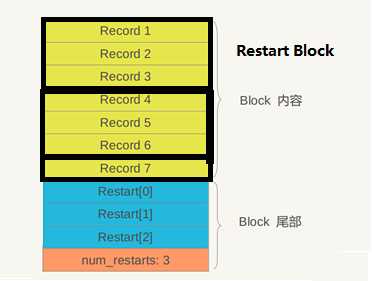标签:
上一节提到的MemTable是内存表,而当内存表增长到一定程度时(memtable.size> Options::write_buffer_size),会将当前的MemTable数据持久化(LevelDB中实际有两份MemTable,后面LevelDB数据库备忘时会讲)。持久化的文件(sst文件)称之为Table,LevelDB中的Table分为不同的层级,当前版本的最大层级为7(0-6),table中level0的数据最新,level6的数据最旧。
Compaction动作负责触发内存表到SSTable的转换,LOG恢复时也会执行,这里不关心Compaction或恢复的任何细节,后面会单独备忘。
LevelDB通过BuildTable方法完成SSTable的构建,其创建SSTable文件并将memtable中的记录依次写入文件。BuildTable带了一个输出参数,FileMetaData:
1 struct FileMetaData { 2 int refs; 3 int allowed_seeks; // Seeks allowed until compaction 4 uint64_t number; 5 uint64_t file_size; // File size in bytes 6 InternalKey smallest; // Smallest internal key served by table 7 InternalKey largest; // Largest internal key served by table 8 9 FileMetaData() : refs(0), allowed_seeks(1 << 30), file_size(0) { } 10 };
number为一个递增的序号,用于创建文件名,allowed_seeks作者有提到,是当前文件在Compaction到下一级之前允许Seek的次数,这个次数和文件大小相关,文件越大,Compaction之前允许Seek的次数越多,这个Version备忘时也会提。
BuildTable方法中真正做事的时TableBuilder,通过调用Add方法将所有记录添加到数据表中,完成SSTable创建。
TableBuilder主要做了如下几件事:
其中阶段1-3由Add方法完成,阶段4由Finish方法完成,先来看Add方法:
1 void TableBuilder::Add(const Slice& key, const Slice& value) { 2 Rep* r = rep_; 3 assert(!r->closed); 4 if (!ok()) return; 5 if (r->num_entries > 0) { 6 assert(r->options.comparator->Compare(key, Slice(r->last_key)) > 0); 7 } 8 9 //Index Block:Data Block的索引元数据。 10 if (r->pending_index_entry) { 11 assert(r->data_block.empty()); 12 r->options.comparator->FindShortestSeparator(&r->last_key, key); 13 std::string handle_encoding; 14 r->pending_handle.EncodeTo(&handle_encoding); 15 r->index_block.Add(r->last_key, Slice(handle_encoding)); 16 r->pending_index_entry = false; 17 } 18 19 r->last_key.assign(key.data(), key.size()); 20 r->num_entries++; 21 r->data_block.Add(key, value); 22 23 const size_t estimated_block_size = r->data_block.CurrentSizeEstimate(); 24 if (estimated_block_size >= r->options.block_size) { 25 Flush(); //超过单数据块大小,写入文件。 26 } 27 }
Add方法创建Data Block、IndexBlock,DataBlcok通过Flush刷入磁盘文件。
再来看Finish方法:
1 Status TableBuilder::Finish() { 2 //Data Block 3 Rep* r = rep_; 4 Flush(); 5 6 assert(!r->closed); 7 r->closed = true; 8 9 //Meta Block 10 BlockHandle metaindex_block_handle; 11 BlockHandle index_block_handle; 12 if (ok()) 13 { 14 BlockBuilder meta_index_block(&r->options); 15 // TODO(postrelease): Add stats and other meta blocks 16 WriteBlock(&meta_index_block, &metaindex_block_handle); 17 } 18 19 //Index Block 20 if (ok()) { 21 if (r->pending_index_entry) { 22 r->options.comparator->FindShortSuccessor(&r->last_key); 23 std::string handle_encoding; 24 r->pending_handle.EncodeTo(&handle_encoding); 25 r->index_block.Add(r->last_key, Slice(handle_encoding)); 26 r->pending_index_entry = false; 27 } 28 WriteBlock(&r->index_block, &index_block_handle); 29 } 30 31 //Footer 32 if (ok()) 33 { 34 Footer footer; 35 footer.set_metaindex_handle(metaindex_block_handle); // 36 footer.set_index_handle(index_block_handle); 37 std::string footer_encoding; 38 footer.EncodeTo(&footer_encoding); 39 r->status = r->file->Append(footer_encoding); 40 if (r->status.ok()) { 41 r->offset += footer_encoding.size(); 42 } 43 } 44 return r->status; 45 }
Finish依次写入:尚未写入的最后一块Data Block及Meta Block、Index Block、Footer。Meta Block暂未使用,Footer则保存了meta block、index block的位置信息。
Block
Data Block、Meta Block、Index Block是业务划分,分别代表用户数据块、元数据块及用户数据索引块。其存储格式均为Block结构:

Record代表一条数据,蓝色及红色部分(统一称作”重启点”)为附加信息,而这些是做什么的呢?两点:性能优化、节省空间。
我们先来看Restart列表的构建逻辑:
1 void BlockBuilder::Add(const Slice& key, const Slice& value) { 2 Slice last_key_piece(last_key_); 3 ...... 4 size_t shared = 0; 5 if (counter_ < options_->block_restart_interval) { 6 // See how much sharing to do with previous string 7 const size_t min_length = std::min(last_key_piece.size(), key.size()); 8 while ((shared < min_length) && (last_key_piece[shared] == key[shared])) { 9 shared++; 10 } 11 } 12 else { //restart时保存完整的key值 13 // Restart compression 14 restarts_.push_back(buffer_.size()); 15 counter_ = 0; 16 } 17 const size_t non_shared = key.size() - shared; 18 19 //Record信息 20 // shared size | no shared size | value size | no shared key data | value data 21 // Add "<shared><non_shared><value_size>" to buffer_ 22 PutVarint32(&buffer_, shared); 23 PutVarint32(&buffer_, non_shared); 24 PutVarint32(&buffer_, value.size()); 25 // Add string delta to buffer_ followed by value 26 buffer_.append(key.data() + shared, non_shared); 27 buffer_.append(value.data(), value.size()); 28 29 // Update state 30 last_key_.resize(shared); 31 last_key_.append(key.data() + shared, non_shared); 32 assert(Slice(last_key_) == key); 33 counter_++; 34 }
每隔一定间隔(block_restart_interval)Record就会创建一个新的重启点,重启点内容为当前block的大小,即重启点在block内的偏移。
每当添加一个新的重启点时,重启点指向位置的Record中一定保存了完整的key值(shared size = 0),随后的Record中保存的key值仅为和上一个Record的差异值。因为Key在Block中是有序排列的,所以相邻key值重叠区域节省的空间还是非常可观的。
基于上述实现,问题来了:当需要定位一条记录时,因为record中key的信息是不完整的,仅包含了和上一条的差异项,但上一条记录本身也只包含了和再上一条的差异项,那么定位一条记录时如何做key比较?如果需要一直向上查找完成key值拼接,性能上会不会有损伤?
分析这个问题就要了解重启点的定位:Block的一级索引,SSTable的二级索引(Index Block是SSTable的一级索引)。本文将每个重启点记录位置所属的Record列表称为一个Restart Block
假设每条record记录的都是完整的key值时,从SSTable中查找一条记录的工作流如下:
在上述流程中,我们必定会先找到一个Restart Point,随后进行key值比较,而Restart Point记录本身包含了完整的key值信息,后续key值均可基于此key得到。
Restart列表本身做为索引,提升了查找性能,而key值存储的小技巧又降低了空间使用率,在不损伤性能的情况小降低空间利用率,这是一个很好的例子。
即使这样,作者觉得还不够,空间利用率还可以进一步优化,并且不损伤任何读取数据的性能。
做法和Restart列表的做法类似,是在Index Block中,通过调用FindShortestSeparator / FindShortSuccessor方法实现。
1 // If *start < limit, changes *start to a short string in [start,limit). 2 // Simple comparator implementations may return with *start unchanged, 3 // i.e., an implementation of this method that does nothing is correct. 4 virtual void FindShortestSeparator(std::string* start, const Slice& limit) const = 0; 5 6 // Changes *key to a short string >= *key. 7 // Simple comparator implementations may return with *key unchanged, 8 // i.e., an implementation of this method that does nothing is correct. 9 virtual void FindShortSuccessor(std::string* key) const = 0;
FindShortestSeparator找到start、limit之间最短的key值,如“helloworld”和”hellozoomer”之间最短的key值可以是”hellox”。FindShortSuccessor则更极端,用于找到比key值大的最小key,如传入“helloworld”,返回的key值可能是“i”而已。
标签:
原文地址:http://www.cnblogs.com/desmondwang/p/4814203.html